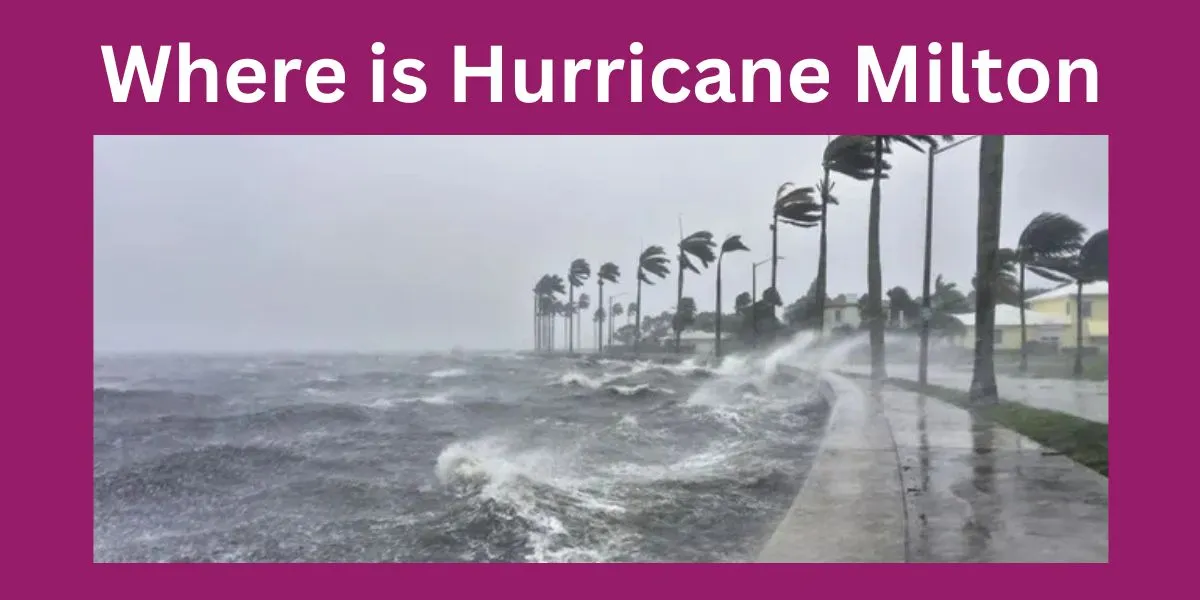Hurricanes are one of nature’s most powerful forces, capable of causing widespread destruction. If you’ve heard about Hurricane Milton and are wondering where it is, how it formed, and what its current path looks like, you’re in the right place. In this article, we’ll break down everything you need to know about tracking hurricanes, the role of meteorological agencies, and how you can stay informed.
Understanding Hurricanes
Before we dive into Hurricane Milton’s location and path, let’s briefly touch on how hurricanes form and why they can be so unpredictable.
What Is a Hurricane?
A hurricane is a large, swirling storm system that forms over warm ocean waters, typically in tropical or subtropical regions. It’s classified as a “tropical cyclone” and has wind speeds of at least 74 mph (119 km/h). Hurricanes are rated on the Saffir-Simpson scale from Category 1 to Category 5, with Category 5 being the most severe.
How Do Hurricanes Form?
Hurricanes form when warm, moist air over the ocean rises, creating a low-pressure area below. As more air moves in to replace the rising air, it too heats up and rises, creating a cycle. The Earth’s rotation causes the air to spiral, and as the system grows, it can develop into a powerful storm.
The Ingredients for a Hurricane
- Warm Ocean Waters: At least 80°F (26.5°C).
- Moist Air: Humidity is key to feeding the storm.
- Weak Wind Shear: Too much wind in the upper atmosphere can disrupt the storm’s formation.
The Birth of Hurricane Milton
So, where does Hurricane Milton fit into all of this? Like many hurricanes, Milton likely started as a tropical depression, then intensified as it moved over warm waters. Once its wind speeds exceeded 74 mph, it officially became a hurricane.
When and Where Did Hurricane Milton Form?
Hurricane Milton likely formed in the tropical Atlantic Ocean, where many hurricanes are born. These areas are often referred to as “hurricane nurseries” due to the perfect conditions for storm formation. While the exact date and location of Milton’s formation depend on real-time data, hurricanes generally form between June and November, known as the Atlantic hurricane season.
Milton’s Early Development
In its early stages, Milton would have been closely monitored by the National Hurricane Center (NHC) and other meteorological agencies. They use satellites, weather balloons, and buoys to track the storm’s development and provide early warnings.
Tracking Hurricane Milton
One of the most common questions people have is, “Where is Hurricane Milton now?” Tracking hurricanes has become a sophisticated process, thanks to advances in technology. Let’s take a look at how Hurricane Milton’s path is being tracked.
How Do Meteorologists Track Hurricanes?
Meteorologists use several tools to track hurricanes, including:
- Satellites: These provide real-time images of the storm from space, allowing scientists to see its size, shape, and movement.
- Doppler Radar: This technology can measure wind speeds and the intensity of rainfall within the storm.
- Weather Stations: Ground-based stations report local weather conditions, helping meteorologists understand how the storm is affecting specific areas.
- Hurricane Hunter Aircraft: These planes fly directly into hurricanes to collect data on wind speeds, pressure, and temperature.
What’s the Current Location of Hurricane Milton?
Hurricane Milton’s current location can be found using real-time tracking websites like the National Hurricane Center’s website or popular weather apps. If Milton is still active, these platforms will show you the latest updates on its location, projected path, and potential impacts.
The Importance of the “Cone of Uncertainty”
When tracking a hurricane’s path, you’ll often see what’s called the “cone of uncertainty.” This represents the possible area where the hurricane could move in the coming days. It’s called the “cone of uncertainty” because hurricanes can change direction, speed, and intensity, making it difficult to predict their exact path beyond a few days.
What Are the Potential Impacts of Hurricane Milton?
If Hurricane Milton is moving toward populated areas, there are several potential impacts to be aware of.
Storm Surge
One of the most dangerous aspects of a hurricane is storm surge—a rise in sea level caused by the storm’s winds pushing water toward the shore. Storm surge can lead to severe flooding, especially in low-lying coastal areas.
Heavy Rain and Flooding
Hurricanes often bring torrential rain, which can cause flooding even in areas far from the coast. Rivers can overflow, and urban areas may experience flash floods.
High Winds
The powerful winds of a hurricane can cause significant damage to buildings, trees, and power lines. This is particularly true for Category 3, 4, and 5 hurricanes.
Tornadoes
Did you know that hurricanes can also spawn tornadoes? While these tornadoes are typically weaker than those formed in the Midwest, they can still cause localized damage.
How to Stay Safe During Hurricane Milton
Whether Hurricane Milton is heading toward your area or not, it’s always a good idea to be prepared. Here are some tips to help you stay safe during hurricane season.
Create an Emergency Kit
Your emergency kit should include essentials like:
- Bottled water (at least one gallon per person per day for three days)
- Non-perishable food
- Flashlights and extra batteries
- A first-aid kit
- Prescription medications
- Important documents (in a waterproof container)
Follow Evacuation Orders
If local authorities issue an evacuation order, don’t hesitate to leave. Even if the weather seems fine, hurricanes can change course or intensify quickly.
Secure Your Home
If you have time, take steps to protect your home:
- Board up windows
- Secure outdoor furniture
- Trim any large trees near your house
Stay Informed
Use weather apps, radio stations, or the National Hurricane Center’s website to stay updated on Hurricane Milton’s path and any advisories for your area.
Conclusion: Be Informed and Prepared
So, where is Hurricane Milton? While its exact location depends on the latest data, the important thing is to stay informed and prepared. Hurricanes can be unpredictable, but with the right tools and information, you can minimize their impact on your life. Remember, meteorologists are tracking Hurricane Milton around the clock to provide the most accurate updates, so keep an eye on those forecasts!
FAQs
1. How can I track Hurricane Milton in real-time?
You can track Hurricane Milton through the National Hurricane Center’s website or weather apps that offer real-time updates. These platforms will show the storm’s current location, wind speeds, and projected path.
2. What should I do if Hurricane Milton is heading toward my area?
If Hurricane Milton is projected to affect your area, follow any evacuation orders from local authorities. Prepare an emergency kit, secure your home, and stay informed using weather apps or radio stations.
3. How long does a typical hurricane last?
Hurricanes can last anywhere from a few days to over a week, depending on various factors like ocean temperatures, wind patterns, and landfall. The average hurricane lasts about 5-10 days.
4. What category is Hurricane Milton?
The category of Hurricane Milton will depend on its current wind speeds. Hurricanes are classified on the Saffir-Simpson scale from Category 1 (74-95 mph winds) to Category 5 (157+ mph winds).
5. Can hurricanes like Milton change direction suddenly?
Yes, hurricanes can change direction due to shifts in atmospheric conditions like high-pressure systems or wind shear. This is why the “cone of uncertainty” is important, as it represents the potential path the hurricane might take.










